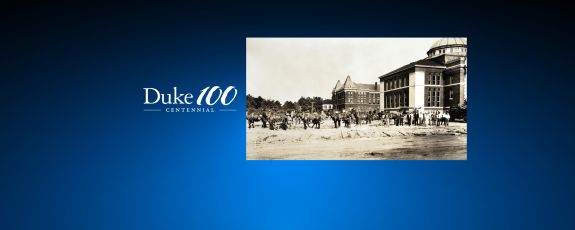
The Building of Duke University Begins
East and West Campus grow quickly in the years following the university's creation in 1924

The work converted the former Trinity College campus into present-day East Campus, meant to house the new Woman’s College, and began turning some of Duke’s approximately 5,000 newly purchased acres of forest and farmland into gothic West Campus. Plans made headlines in The New York Times, The Washington Post, and Los Angeles Times.
The Greensboro Daily News in 1926 reported: “The proposed plans have recently been on exhibition in the Metropolitan Museum of Art in New York City and have attracted wide attention as being the most complete and beautiful university buildings ever seen in America.”

Alice Mary Baldwin, the only female faculty member and Dean of the Woman’s College, served on the building committee. While Frank Brown, the English professor and university comptroller overseeing the building of Duke’s campus, would not discuss plans with Baldwin directly, she pushed for features female students would appreciate: round dining hall tables for better conversation and chairs that fit women’s backs.
“My chief aims were to have full opportunities for the women to share in all academic life,” Baldwin wrote in her 1959 memoir, The Woman’s College as I Remember It.
In 1927, while East Campus was under construction, workers began clearing farmland for the initial 44 buildings on West Campus. The vision for West Campus was inspired by visits that Frank Brown and then-Trinity College President William Preston Few made to Yale, Princeton and the University of Chicago.
Constructing West Campus involved a temporary railroad spur to transport stone quarried from Hillsborough. Masons, including local Black and white laborers, stone cutters from western North Carolina, and Italian immigrants, worked on shaping and placing the stone. The newly created Duke Construction Company and the George A. Fuller Company, a renowned skyscraper builder, collaborated on the job.

A Baltimore Sun story in 1927 said preparing Duke’s site would require “hundreds of men, scores of three-mule teams, trucks, several dozen tractors and a battery of steam shovels.” Payroll ledgers show carpenters, laborers and painters working six days per week for 25 cents to one dollar per hour.
By June 1931, the inaugural commencement occurred on West Campus, where robed graduates walked across lawns once busy with railroads and steam shovels. Duke Chapel’s half-finished tower, shrouded in scaffolding, loomed above.
In his commencement remarks, Duke University President William Preston Few, predicted that the campus, which took seven years to build, would become an enduring source of pride.
He said, “These appropriate and beautiful surroundings will have a transforming influence upon students generation after generation and even upon the character of the institution itself.”
Do you have a story you would like for us to cover for the Centennial year? Send ideas and photographs through our story idea form or write working@duke.edu.
Follow Working@Duke on X (Twitter), Facebook, and Instagram.